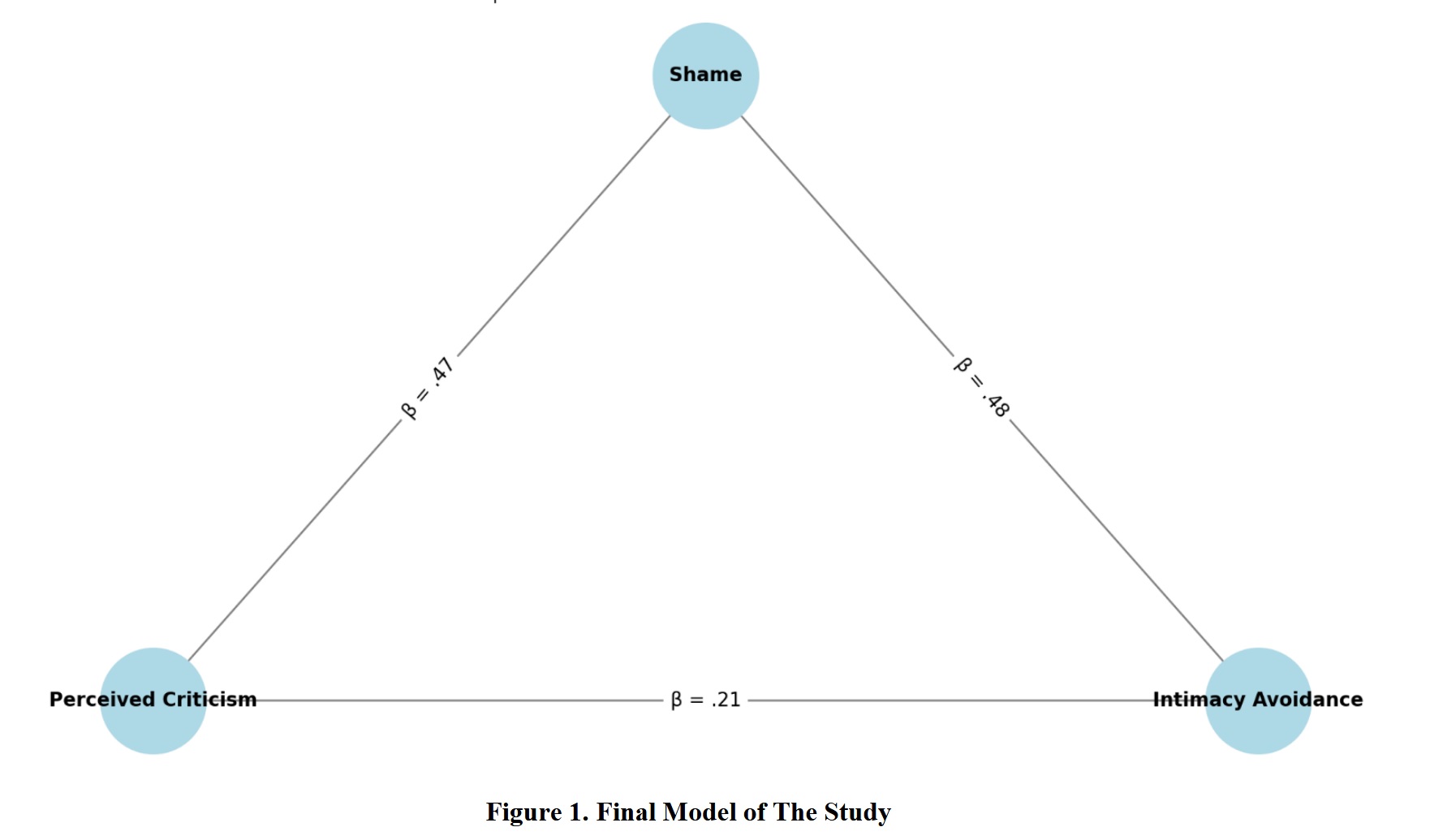Perceived Criticism and Intimacy Avoidance in Couples: The Mediating Role of Shame
Keywords:
Perceived criticism, internalized shame, intimacy avoidance, romantic relationships, structural equation modelingAbstract
This study aimed to examine the mediating role of internalized shame in the relationship between perceived criticism and intimacy avoidance in romantic couples. The study utilized a descriptive correlational design involving 400 adult participants from India, selected based on the Krejcie and Morgan (1970) sample size table. Standardized instruments were used to measure perceived criticism (Perceived Criticism Measure), shame (Experience of Shame Scale), and intimacy avoidance (ECR-R Avoidance Subscale). Data were analyzed using Pearson correlation in SPSS-27 and Structural Equation Modeling (SEM) in AMOS-24 to evaluate the proposed mediational model. Assumptions of normality, linearity, multicollinearity, and homoscedasticity were confirmed prior to analysis. Model fit was assessed using key indices including χ²/df, GFI, AGFI, CFI, RMSEA, and TLI. Pearson correlation analysis showed that perceived criticism was significantly correlated with shame (r = .47, p < .001) and intimacy avoidance (r = .42, p < .001). Shame also showed a strong correlation with intimacy avoidance (r = .53, p < .001). SEM analysis indicated that the model had good fit (χ²/df = 1.74, GFI = 0.94, CFI = 0.96, RMSEA = 0.043). Perceived criticism significantly predicted shame (β = .47, p < .001) and intimacy avoidance directly (β = .21, p = .004). Shame also significantly predicted intimacy avoidance (β = .48, p < .001) and partially mediated the relationship between perceived criticism and intimacy avoidance (indirect β = .23, p < .001). The findings suggest that shame is a key emotional mechanism through which perceived criticism affects intimacy avoidance. Interventions targeting shame regulation may be beneficial for improving relational closeness in couples.
Downloads
References
Cameron, C., Kotera, Y., & Fido, D. (2022). The Relationship Between Sex Addiction and Shame Moderated by Overt and Covert Narcissism in a Gender-Balanced Adult Sample. https://doi.org/10.31234/osf.io/9m4fs
Carabellese, D. J., Proeve, M., & Roberts, R. (2019). Relationship of Patient Shame to Working Alliance and Satisfaction: A Preliminary Investigation. The Journal of Mental Health Training Education and Practice, 14(4), 251-263. https://doi.org/10.1108/jmhtep-10-2017-0059
Frankham, C., Richardson, T., & Maguire, N. (2019). Do Locus of Control, Self-Esteem, Hope and Shame Mediate the Relationship Between Financial Hardship and Mental Health? Community Mental Health Journal, 56(3), 404-415. https://doi.org/10.1007/s10597-019-00467-9
Jeon, S., & Park, K.-H. (2023). The Relationship Between Internalized Shame and Self-Concealment: The Mediating Effects of Fear of Negative/Positive Evaluation and Self-Compassion. Korean Association for Learner-Centered Curriculum and Instruction, 23(23), 507-520. https://doi.org/10.22251/jlcci.2023.23.23.507
Jung, Y., & Ha, M. (2023). The Dual Mediating Effects of Internalized Shame and Self-Criticism in the Relationship Between Covert Narcissism and Relation Addiction of Early Adulthood. Korean Soc Cult Converg, 45(6), 453-465. https://doi.org/10.33645/cnc.2023.06.45.06.453
Kang, Y.-S., & Jo, Y. (2023). The Effects of Adult Attachment on the Satisfaction of Romantic Relationship: The Mediating Effects of Internalized Shame and Perfectionism of Romantic Relationship. Korean Association for Learner-Centered Curriculum and Instruction, 23(2), 345-361. https://doi.org/10.22251/jlcci.2023.23.2.345
Kim, M. S., & Kim, E. J. (2023). The Effects of Internalized Shame on Suicidal Ideation Among College Students: Mediation Effects of Self-Concealment and Entrapment. Korean Association for Learner-Centered Curriculum and Instruction, 23(5), 217-230. https://doi.org/10.22251/jlcci.2023.23.5.217
Krishna, A., Soumyaja, D., & Sowmya, C. S. (2023). Workplace Bullying and Diffident Silence: A Moderated Mediation Model of Shame and Core Self-Evaluation. International Journal of Conflict Management, 34(3), 417-439. https://doi.org/10.1108/ijcma-04-2022-0075
Lee, S., & Kim, S. H. (2023). The Influence of Insecure Adult Attachment on Depression: The Mediating Effect of Internalized Shame and Mentalization. Korean Association for Learner-Centered Curriculum and Instruction, 23(10), 199-214. https://doi.org/10.22251/jlcci.2023.23.10.199
Leonard, K. A., Ellis, R. A., & Orcutt, H. K. (2020). Experiential Avoidance as a Mediator in the Relationship Between Shame and Posttraumatic Stress Disorder: The Effect of Gender. Psychological Trauma Theory Research Practice and Policy, 12(6), 651-658. https://doi.org/10.1037/tra0000601
Lian, Y., Liu, L., Lu, Z. a., & Wang, W. (2022). Longitudinal Relationships Between Bullying and Prosocial Behavior: The Mediating Roles of trauma‐related Guilt and Shame. PsyCh Journal, 11(4), 492-499. https://doi.org/10.1002/pchj.540
O’Loghlen, E., Galligan, R., & Grant, S. (2023). Childhood Maltreatment, Shame, Psychological Distress, and Binge Eating: Testing a Serial Mediational Model. https://doi.org/10.21203/rs.3.rs-2769149/v1
Oh, Y., & Rhee, M. K. (2021). Relationship Between Complex Trauma Experience in Childhood-Adolescence and Interpersonal Trauma in Adulthood: Mediating Effects of Dissociation Experience, Relationship Addiction, and Internalized Shame. Korean Journal of Stress Research, 29(1), 1-10. https://doi.org/10.17547/kjsr.2021.29.1.1
Salemi, E., Mirzazade, Z., Dehshiri, G., & Zahraei, S. (2022). Sensitivity to Punishment and Emotional Eating: The mediating Role of Shame and Rumination. Psychology and Psychotherapy Theory Research and Practice, 95(4), 875-887. https://doi.org/10.1111/papt.12407
Santos, S., & Salvador, M. d. C. (2021). Depression in Institutionalized Adolescents: The Role of Memories of Warmth and Safeness, Shame and Self-Criticism. The Spanish journal of psychology, 24. https://doi.org/10.1017/sjp.2021.27
Scheer, J. R., Harney, P. A., Esposito, J., & Woulfe, J. (2020). Self-Reported Mental and Physical Health Symptoms and Potentially Traumatic Events Among Lesbian, Gay, Bisexual, Transgender, and Queer Individuals: The Role of Shame. Psychology of violence, 10(2), 131-142. https://doi.org/10.1037/vio0000241
Shim, M. J. (2022). Mediating Effects of Shame and Self-Acceptance in the Relationship Between Emotional Perception Clarity and Subjective Well-Being of Adults. Korean Association for Learner-Centered Curriculum and Instruction, 22(16), 829-844. https://doi.org/10.22251/jlcci.2022.22.16.829
Sim, H. R., & Choi, H. N. (2023). The Moderated Mediating Effect of Self-Compassion on the Relationship Between Internalized Shame, Rumination, and Interpersonal Satisfaction. Korean Association for Learner-Centered Curriculum and Instruction, 23(11), 479-495. https://doi.org/10.22251/jlcci.2023.23.11.479
Türk, F., Kellett, S., & Waller, G. (2021). Determining the Potential Link of Self-Compassion With Eating Pathology and Body Image Among Women: A Longitudinal Mediational Study. Eating and Weight Disorders - Studies on Anorexia Bulimia and Obesity, 26(8), 2683-2691. https://doi.org/10.1007/s40519-021-01144-1
Wood, L., & Irons, C. (2017). Experienced Stigma and Its Impacts in Psychosis: The Role of Social Rank and External Shame. Psychology and Psychotherapy Theory Research and Practice, 90(3), 419-431. https://doi.org/10.1111/papt.12127

Downloads
Published
Submitted
Revised
Accepted
Issue
Section
License

This work is licensed under a Creative Commons Attribution-NonCommercial 4.0 International License.
